 Fast
Growing Trees
Fast
Growing Trees
Fast growing trees are an excellent way to start off an almost bare garden or fill a gap and get an air of maturity sooner rather than later
![]() Fast growing plants in general put their
energy into lots of prodigious leafy growth and height.
Fast growing plants in general put their
energy into lots of prodigious leafy growth and height.
![]() There is usually little energy left for flowers or fruit.
There is usually little energy left for flowers or fruit.
![]() Fast growth often means greedy feeders with aggressive often
shallow roots so frequently little can be grown at the base
of these trees.
Fast growth often means greedy feeders with aggressive often
shallow roots so frequently little can be grown at the base
of these trees.
The longer term answer therefore is to plant some fast growers and then back them up with stronger, long-lived trees that provide elegant architectural shapes, flowers, fruit, bark, autumn colors etc.
Fast, Faster or Fastest, you won't be far off if you assume than growth rate is the opposite of wood strength and particularly - longevity.
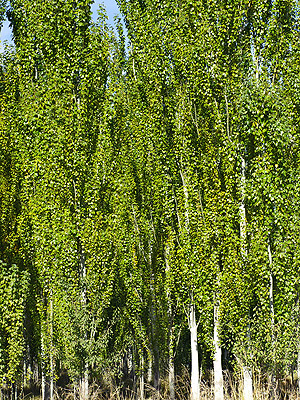
Poplar-
Populus
Faster
Buy Poplars
Amongst the fastest growing
trees in good conditions. Hardy though relatively short lived,
expect 30-50 years with any more as a bonus, generally wind,
insect and disease resistant. They thrive even in cold conditions.
Good for screening. Ensures privacy between houses and serves
as a windbreak or fence on farms. Planted 18" apart they quickly
grow into a solid green (deciduous) hedge.
Willows or poplars shouldn't be planted within 140 feet of a house or drains to be safe. They have very vigorous far reaching roots and are thirsty enough to make the soil expand and contract with the uptake of water so threatening foundations.
To 60 feet tall and 30 foot spread, deciduous
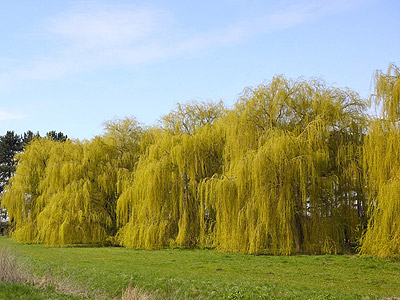
Weeping Willow-
Salix niobe / Salix babylonica
Fastest
One of the fastest-growing trees. Grows as much as eight to ten feet a year under ideal conditions, 2 feet or so is more common. Slender, graceful drooping branches and fine, narrow, leaves that change to a rich golden color in autumn. Handsome bark gives winter interest too. The weeping willow thrives in moist as well as dry locations, frequently growing alongside river banks with a portion of the roots under water which it likes best. Tolerant of smog and smoke.
Other willows are also quick growers, though of more characteristic tree shape rather than having the weeping branches.
Willows or poplars shouldn't be planted within 140 feet of a house or drains to be safe. They have very vigorous far reaching roots and are thirsty enough to make the soil expand and contract with the uptake of water so threatening foundations.
To 50 feet high and 40 foot spread, deciduous
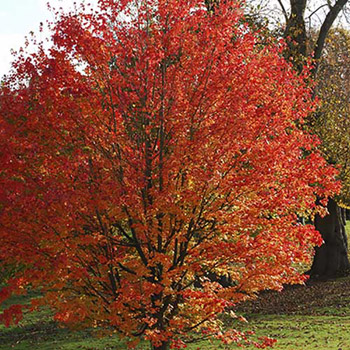 Maples
- Acer
Maples
- Acer
Fast
Buy Maples
(note the commonly available Japanese maples, Acer palmatum,
are slow growing)
There are a whole host of maples, species and cultivars, they are all pretty fast growers (other than the slow growing Japanese maples) good as windbreak trees. Attractive foliage that frequently turns golden yellow or orange-red in autumn.
To 80 feet tall with a 50 foot spread, deciduous.
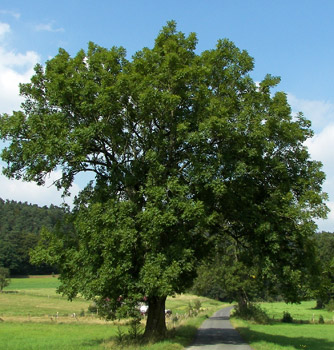 Ash
-
Fraxinus spp.
Ash
-
Fraxinus spp.
Faster
To 40 - 60 feet tall, similar spread with an oval crown. Zones 3 to 9, deciduous.
European or common ash tree, Fraxinus excelsior, is the most commonly encountered variety, native throughout the UK and Europe.
A number of different cultivars are available of the green and white ashes.
Green Ash tree, Fraxinus pennsylvanica, is a fast growing shade tree with rich green foliage and an upswept branching habit. It is very adaptable.
White Ash tree, Fraxinus americana, is a handsome native tree. It develops an open and rather round topped crown in its old age.
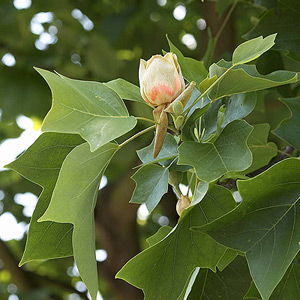 Tulip
Poplar-
Liriodendron tulipifera
- Faster
Tulip
Poplar-
Liriodendron tulipifera
- Faster
Excellent specimen trees where the shapely form can best be appreciated. Sometimes sold on the strength of masses of tulip-like flowers in the spring. It's true that they do produce them, though they are not so obvious from a distance their pale green and yellow color blending in with the trees' leaves. The leaves are deep green and turn a blazing golden yellow in autumn. A valuable shade tree Fast-growing, hardy and resistant to insects and diseases.
To 80 feet tall, deciduous.
 Colorado
Blue Spruce-
Picea pungens glauca
- Fast
Colorado
Blue Spruce-
Picea pungens glauca
- FastBuy Blue Spruce
Excellent reasonably fast growing evergreen tree. Glistening, steel blue coloring and graceful conical shape. So dense growing these make superb windbreaks or privacy screens where there is space enough for large spreading trees. Makes a great outdoor Christmas tree to festoon with lights. It prefers heavier soils and full sun.
To 50 feet tall and 20 foot spread, evergreen
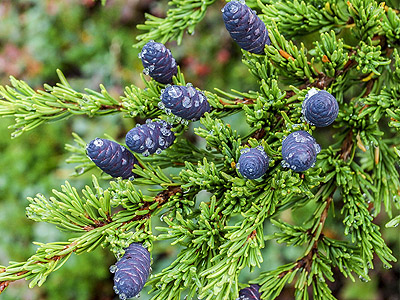
Canadian Hemlock- Tsuga canadensis - Faster
The Canadian Hemlock tree, Tsuga canadensis, is also called Eastern Hemlock or Hemlock spruce. For use as a specimen tree or as an excellent hedge. Canadian Hemlock is often called the most graceful of all evergreens. The foliage is a soft blue green color that grows in flat, feathery layers all the way to the ground. It can be cut to any formal shape desired as well as a privet hedge can. Whether sheared, or left unsheared, this hedge remains neat and attractive. Easily adapts to a wide range of soils, requires protection from prevailing winds the first year planted, NOT drought tolerant. Will grow 1-3' annually.To 70 feet tall and 30 foot spread, evergreen.
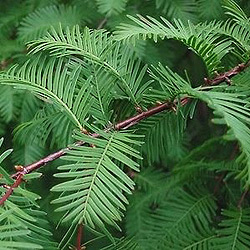 Dawn
Redwood -
Metsequoia glyptostroboides
- Faster
Dawn
Redwood -
Metsequoia glyptostroboides
- Faster
Flourishes in almost any soil or climate, on dry sites growth slows after approx. 30 feet tall, in moist or even damp or waterlogged soils it keeps on going. A handsome narrowly conical specimen tree, plant it, water, and stand back to watch it grow 3 - 6' a year with no spraying, fertilizing, pruning or cutting. From springtime green, the fern-like leaves turn orange-brown to dark brown in the autumn.
To 70 - 130 feet tall and 15 foot spread or more, evergreen.
 Scots
Pine -
Pinus sylvestris -
Fast
Scots
Pine -
Pinus sylvestris -
Fast
A magnificent tree, tall and stately, will grow up to 2 feet in a season. Pyramidal when young, then develops to conical to columnar-conical shape. Stiff, bluish-green needles stay dense and thick all year long, blocks wind with a vengeance.
To 50 - 100 feet tall with a 20 - 28 foot spread - evergreen
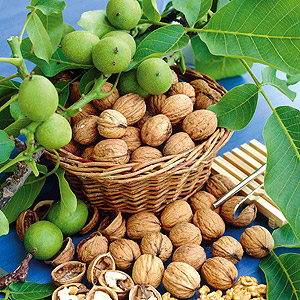
Walnut - Juglans - reasonably fast growing, slow to establish
The walnut is a good cropper in climates where summers are suitably long and warm to give the nuts time to ripen properly. It is a good shapely shade tree, not as fast growing as many on this page, but longer lived, sturdier, provides valuable wood and of course plenty of walnuts.
To 40 feet tall and wide, deciduous.
To maintain a fast growth rate, these trees have to be grown in good conditions. This means no competition around them from other trees or bushes. When planting them use plenty of organic matter to get them off to a good start, clear an area around the tree of grass to a radius of 12-24" (30-60cm) and keep it grass and weed free for the first couple of years. Give them a bucket of water once a week or so during dry spells in the growing season for the first year at least, then once established, they can be left to their own devices.
Picture credits: Ash tree - Willow, used under Creative Commons Attribution-Share Alike 3.0 Unported license.
Copyright 2000 - present. All Rights Reserved | Privacy Policy Statement
